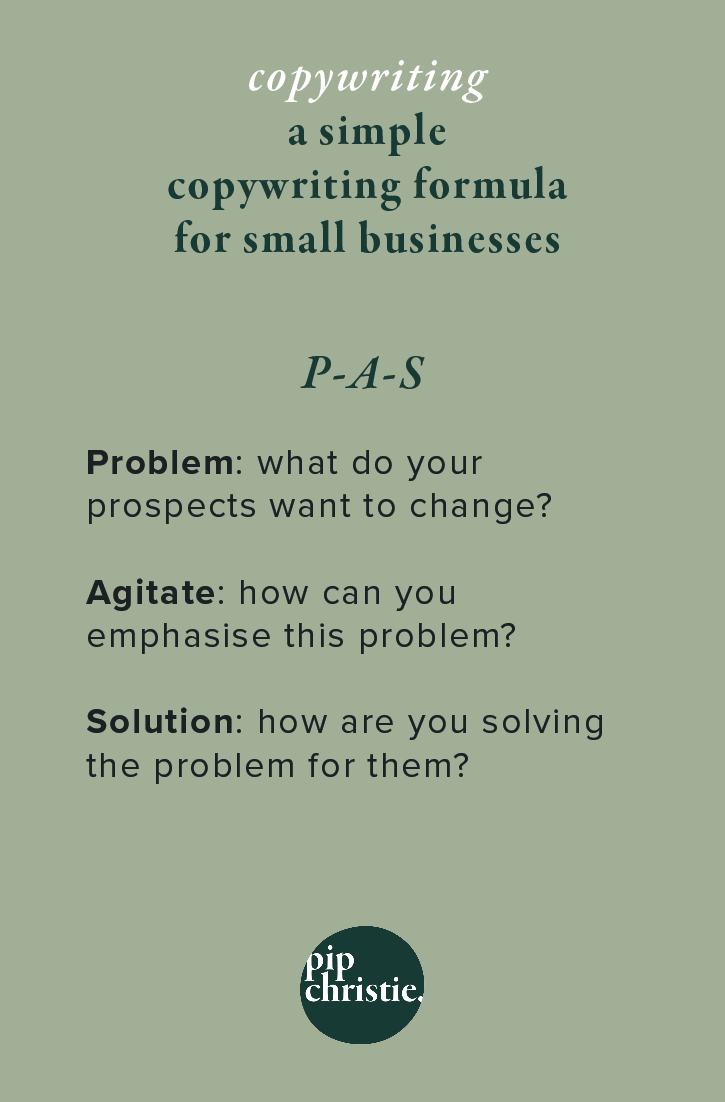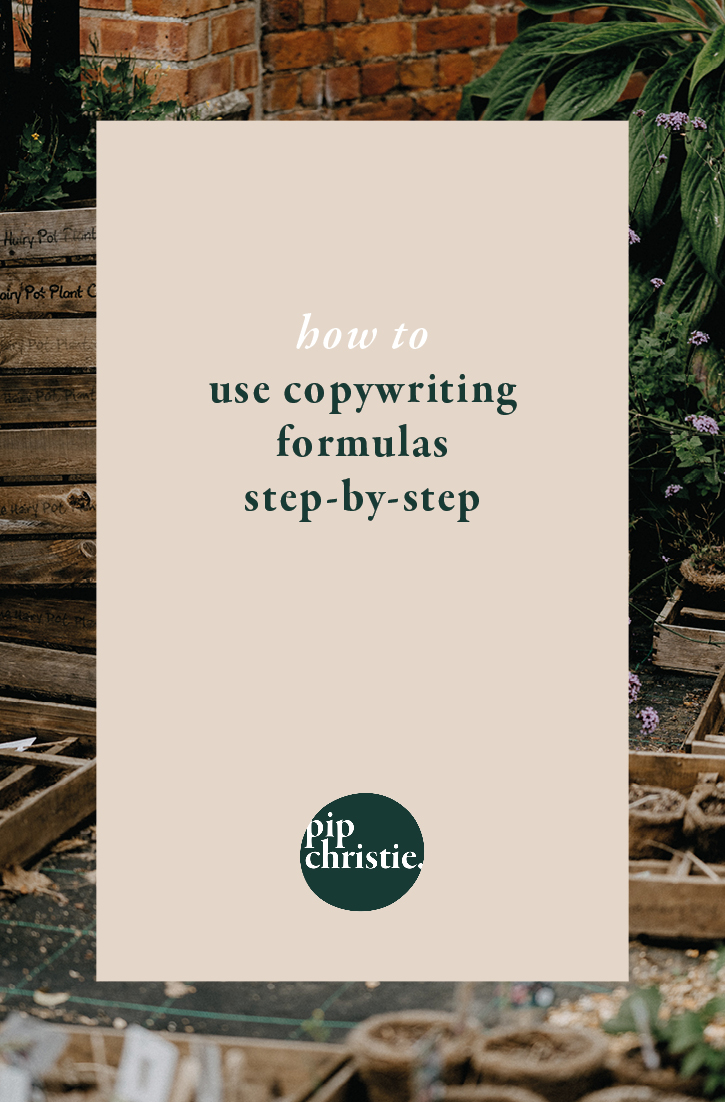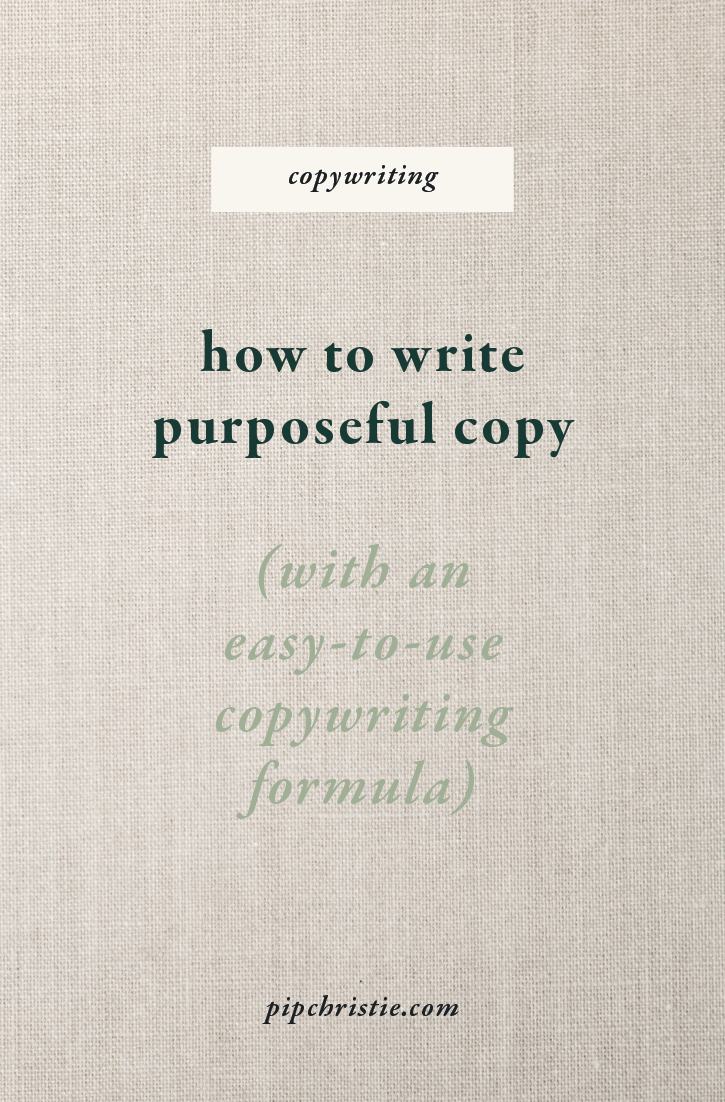A Simple Copywriting Formula For Your Small Business
Ever sat down to write something for your website, only to spend the first-hour typing, deleting, editing, doubting and then (finally) giving up? You need a copywriting formula.
Unlike templates, copywriting formulas are frameworks to follow. You’re able to adapt your copywriting formula to match your brand personality, use your customer insights and hone in on your business’s tone of voice. They create the outline and structure for your page so that you have a guide to follow, without any of the guesswork that comes with writing your copy from scratch.

The classic copywriting formula
“PAS” has been described as the most reliable copywriting formula out there. Why is it so popular?
Well, it’s simple, memorable, effective and incredibly adaptable. You can use the PAS copywriting formula for landing pages, website pages, email marketing copy, social media posts and so much more. And it can be adapted to suit a whole array of different business types. There’s a reason why I use it with so many of my copywriting clients.
Here how it works.
The classic adaptation of the PAS copywriting formula is:
- Problem
- Agitate
- Solution
You’ll start your copy by honing in on your prospect’s problem, before amplifying it and then presenting your solution at the end. This is a great approach for someone who’s stuck in the problem stage, they know what’s wrong but they’re not quite sure how to change it.
Another, newer application is:
- Promise
- Amplify
- Solution
This takes a slightly different angle, looking at the copy from a positive results-focused point of view. It works well when you’re talking to a prospect who’s already dreaming of what’s next. They know that there’s something different for them out there and they’re imagining life with that change, they know how they want to feel.
Both of these approaches follow the concept of meeting your reader where they’re currently at before guiding them to take action at the end. You’re showing them the path to make change easier and more accessible.
You don’t feel confident directing your dream clients to look at your current website
How do you feel each time you send your website’s URL out to a potential client? Or how about when a client says “oh don’t worry I’ll just have a look on your website!”?
Is it a feeling of celebration and excitement at what they’ll discover there? Or does your stomach drop faster than the Times Square ball on New Year’s Eve?
If your current site is more you at the end of an all night work session as opposed to you coming out of the hairdressers after a three hour glam session, then it’s probably time for a new website. Your website should be putting your best foot forward, it should showcase the best version of you and your business, and it should be doing the hard work of nurturing your dream customers for you.
The majority of consumers won’t consider a small business if they can’t easily find information about them online. Your website needs to give the same warm welcome that you’d give those customers if they walked into your store or came up to you at an event. If it’s not doing that, you’re doing your business (and those customers) a disservice. Because they’re missing out on all the wonderful things your business has to offer.
The P
Option A – Problem
Marketers like to talk about the fact that every business out there is solving a “problem”. But I actually find that this can be incredibly misleading. We’re not all fixing tyres or delivering medical procedures. What if you’re just bringing people joy instead?
Sure, each time I order a coffee it might be solving the “problem” of me being tired. But my main motivation for that purchase isn’t the fact that I’m feeling lethargic, it’s that I know that that little cup of caffeine will bring me a chat with a friendly barista, new flavours curated from across the globe, a cosy feeling of comfort with each sip and the satisfaction that I’m supporting a small business.
That one cup of coffee can turn a gloomy day back into a joyful one.
Your business might not be changing the world but I can guarantee you that each product or service you’re offering IS changing someone’s day.
So, instead of looking at problems, I like to look for the change.
“What is your business changing for your dream customers?”
Take a deep dive into what your customer is really feeling and hone in on it. It could be that your customer’s “problem” is that they can’t find natural candles that look as good as they smell. Or, is it more likely that they’re stressed, busy and are struggling to wind down?
Try to look for the deeper problem and speak to it in a way that will connect with the reader right away. Hook them so that they read your words and say “oh my goodness, that’s me”.
Remember, a lot of people won’t resonate – that’s good, they’re not your people! We just want to connect with your right customers.
Option B – Promise
The promise approach is slightly different. This route is about speaking to life after the solution (but without actually mentioning the solution itself!).
Spend some time looking at the key outcomes of your product or service. What do you hear about the most in your feedback from customers? What are the reasons people buy from you, and how does this impact their lives in the longterm?
Choose just one (we don’t want to confuse people with too many messages) and show it to your reader. Help them imagine how this change could look, feel, taste, smell or sound. Tune into their sense and help your reader feel as though they’re already there. You want to get them excited about it.
The A
Option A – Agitate
If you’ve taken the problem approach, step two is to really agitate that problem. Push on it and remind the reader of what life would be like if everything stayed the same.
Your solution is going to help the reader do something really wonderful, you’re changing things for the better and helping them to move forwards. This means that they need to remember exactly why that change is so important to them.
Get specific and maybe even a little playful. Remind the reader of the scenarios or situations that can be oh so frustrating before showing them how they don’t need to happen ever again.
Option B – Amplify
If you’re following the promise approach, you now need to amplify that promise. Paint the picture of what life could be like for your reader if this promise was true.
If this was their life, how would they feel? How would it look? What worries or concerns would be gone? Again, get really specific so that you can make this promise as real as possible for them. After all, you’re about to show them that it is just that – it’s real.
The S
Options A & B – Solution
This is the final stage of the PAS copywriting formula – the solution. This is where you finally get to talk about your product or service. Yep, all the way down here! Patience is the name of the game when it comes to purposeful copywriting.
Remember, just like in real life, you’ve got to start the conversation before you can start talking about yourself. And even still, you’re going to need to talk about yourself in a way that matches up with your prospect’s needs.
Continue with the messaging that you’ve been using in your copy above, and weave that into your solution. Speak to how your product solves the problem or achieves the promise you just walked them through.
You can do this using value-based statements, weaving in social proof and testimonials, speaking to outcomes and benefits (not features) and by being purposeful in your messaging.
There you have it – a simple copywriting formula that can be adapted for any business. It’s versatile, effective and (once you’ve had some practice) easy to use. Just be sure to think carefully and dive deep into the mind of your reader, think about what your dream customer really wants.
Write your website copy like a pro copywriter (without the pro price tag)
Introducing... the about page roadmap.
You’ll get access to the same copywriting framework I use with my small business clients. So you can have an about page that feels 100% you.





